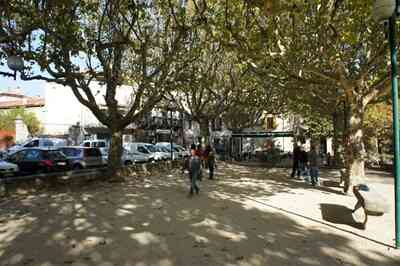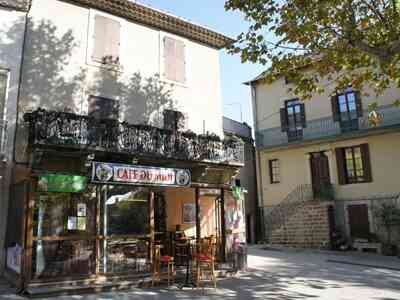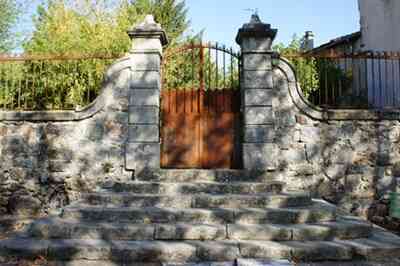Génolhac in Gard |

 Génolhac is a French commune located in the Gard department in the Occitanie region. It is situated in the Cevennes and has approximately 1,100 inhabitants. Génolhac is known for its historical heritage, particularly its 12th-century Romanesque church, as well as its exceptional natural setting, with mountain, forest, and river landscapes conducive to outdoor activities such as hiking and swimming. The commune is also located near tourist sites such as Mont Lozère and the Tarn gorges. Génolhac is a top destination for those seeking tranquility and the beauty of the natural landscapes of the Cevennes, as well as for history and heritage enthusiasts.
Génolhac is a French commune located in the Gard department in the Occitanie region. It is situated in the Cevennes and has approximately 1,100 inhabitants. Génolhac is known for its historical heritage, particularly its 12th-century Romanesque church, as well as its exceptional natural setting, with mountain, forest, and river landscapes conducive to outdoor activities such as hiking and swimming. The commune is also located near tourist sites such as Mont Lozère and the Tarn gorges. Génolhac is a top destination for those seeking tranquility and the beauty of the natural landscapes of the Cevennes, as well as for history and heritage enthusiasts.
 It includes 7 small communes with 100 to 850 inhabitants at the foot of Mont Lozère, between 500m and 1000m above sea level, with access to SNCF Paris Marseille (Paris 637 km, Marseille 215 km).
It includes 7 small communes with 100 to 850 inhabitants at the foot of Mont Lozère, between 500m and 1000m above sea level, with access to SNCF Paris Marseille (Paris 637 km, Marseille 215 km).
Church with a comb-shaped belfry and a square tower from the old castle, both dating from the 12th century. Grande Rue is lined with old houses whose facades have been modified several times from the 12th and 17th centuries, narrating the economic history of the town. The Arceau, built in the 16th century outside the ramparts to shelter the market. At the foot of the town, the temple occupies the site of an old Jacobin convent founded in 1312 by the de Randon family.
The village was surrounded by agricultural land, vineyards, cereal fields, and meadows. By the river, called "Merdarier", a very evocative name, one notes the presence of numerous mills (the moly) and can easily discern the "gourgues" preceding them to give sufficient pressure and flow to the water to drive the horizontal wheels that, in turn, drive the rotating millstone over the fixed one, the "dormante".
 Our Grand rue is then called the straight street. In principle, it is the passage of the famous "Régordane". It enters and exits the city through two portals. Thus, even today, the lower part of the Grand rue ends at Piedeville and the northern quarter is named after the bridge over the Gardonnette, the "city head" (cap de ville). It is worth noting that the Ayres square, in front of the current pharmacy, is already dedicated to grain threshing, which was a craft in which both men and women played an important part.
Our Grand rue is then called the straight street. In principle, it is the passage of the famous "Régordane". It enters and exits the city through two portals. Thus, even today, the lower part of the Grand rue ends at Piedeville and the northern quarter is named after the bridge over the Gardonnette, the "city head" (cap de ville). It is worth noting that the Ayres square, in front of the current pharmacy, is already dedicated to grain threshing, which was a craft in which both men and women played an important part.
Our famous square at Colombier is still a very large meadow, property of the Dominican convent (facing the current tobacco shop). Finally, one can clearly discern the castle and its enclosure with a cemetery, the church and its tower. It is also encircled by walls and ditches. It is noted that nearby is the garden of Monsignor the Bishop (who is in Uzès). When wandering through our alleys, one can confirm the smallness and narrowness of the dwellings, but also sometimes discover beautiful vaults leading to the gardens.
 In the Middle Ages, before the Hundred Years' War, the village of Génolhac was surrounded by ramparts and crossed by the Régordane road that originally passed over the village (currently a road leading to the small industrial zone). The GR®700 Régordane enters Génolhac through the fortified door at the bridge, to the nora. It exits through the fortified door to "Midi or Alès" or from Portalesse... to sua. There was also the Enclos au Chastel and its old portal. The castle surrounded by water ditches serving as moats. Currently, a whole underground network still exists... Later, houses were built along the Régordane path outside the enclosure of the ramparts. One of them, the first to the west on the path, outside the Portal, is separated from the ramparts by the transverse square "at the Portal". It belongs to noble or notable families: Flandin, Patriarche, Milon, Laurents... etc.
In the Middle Ages, before the Hundred Years' War, the village of Génolhac was surrounded by ramparts and crossed by the Régordane road that originally passed over the village (currently a road leading to the small industrial zone). The GR®700 Régordane enters Génolhac through the fortified door at the bridge, to the nora. It exits through the fortified door to "Midi or Alès" or from Portalesse... to sua. There was also the Enclos au Chastel and its old portal. The castle surrounded by water ditches serving as moats. Currently, a whole underground network still exists... Later, houses were built along the Régordane path outside the enclosure of the ramparts. One of them, the first to the west on the path, outside the Portal, is separated from the ramparts by the transverse square "at the Portal". It belongs to noble or notable families: Flandin, Patriarche, Milon, Laurents... etc.
 After the Hundred Years' War, probably in the 15th century, the owner of this house received the privilege of launching an arch over the square, leaning against Nora on the left wall at the Portal, creating a Covered Market or Hall. Later, finally, the remains of the walls on the left and the Portal on the right (bakery side) were destroyed to widen the streets.
After the Hundred Years' War, probably in the 15th century, the owner of this house received the privilege of launching an arch over the square, leaning against Nora on the left wall at the Portal, creating a Covered Market or Hall. Later, finally, the remains of the walls on the left and the Portal on the right (bakery side) were destroyed to widen the streets.
In 1662, the bishop of Uzès ordered the reconstruction of the Dominican convent. From 1681 to 1685, Louvois organized dragoon raids in Poitou, Béarn, and especially in the Cevennes. The King’s soldiers were housed by residents and committed terrible atrocities. The Marquise Marie-Félice de Budos, chatelaine of Portes and Génolhac, is the great organizer and the castle of Portes becomes her prison for "Huguenots". This is the Revocation of the Edict of Nantes in 1685. Protestants must return to Catholicism or leave the Kingdom. Their pastors are chased away, their temples destroyed or occupied by Catholics. On May 7, 1686, a massacre of Protestants occurred at Bougès. In 1690, about twenty inhabitants of Génolhac and Vialas were condemned. Jacques de Roche was sent to the galleys where he died in 1694. Jean Bonijols and J. Laurens were executed. In 1693, the Marquise died and her assets passed to the family of Conti. Louis de Bourbon Conti then became lord of Génolhac. From 1685 to 1702, the Protestants suffered or emigrated. It is their children who will awaken the faith and also the Protestant fury.
Génolhac, the fief of the camisard leader Joani who massacred Catholics and set the convent on fire. In retaliation, the royal army, commanded by the memorable Julien (the apostate), massacred all the Protestants. Génolhac, a martyr village in the time of the Cevennes war. Centre for Documentation and Archives of the PNC. Records, translations, and sketches by Jean Pellet.
Former holiday hotel with a garden along the Allier, L'Etoile Guest House is located in La Bastide-Puylaurent between Lozere, Ardeche, and the Cevennes in the mountains of Southern France. At the crossroads of GR®7, GR®70 Stevenson Path, GR®72, GR®700 Regordane Way, GR®470 Allier River springs and gorges, GRP® Cevenol, Ardechoise Mountains, Margeride. Numerous loop trails for hiking and one-day biking excursions. Ideal for a relaxing and hiking getaway.
Copyright©etoile.fr